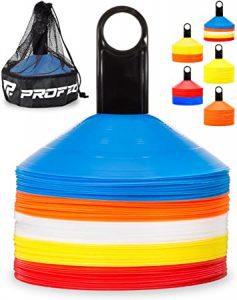The Best Agility Discs
We looked at the top 5 Agility Discs and dug through the reviews from 10 of the most popular review sites including and more. The result is a ranking of the best Agility Discs.

Our Review Process
Don't Waste Your Money is focused on helping you make the best purchasing decision. Our team of experts spends hundreds of hours analyzing, testing, and researching products so you don't have to. Learn more.
Our Picks For The Top Agility Discs
With five high-visibility colors, 50 Pro Disc Cones, a helpful book, holder and carrying bag, this quality soccer training equipment is perfect for the field, track court or gym.
Helps You Improve SpeedInvest some time with these cones, and your players will be ready to tackle the competition in no time flat.
Juvale's affordable agility speed training kit comes with one resistance parachute, a 20-inch adjustable ladder, four steel stakes and six yellow 7-inch disc cones, all in a drawstring bag. Use it to train for soccer, track, football, basketball and other sports.
You Can Do ThisYou’ll see the difference soon after you start practicing with this set; everyone’s speed and moves will be explosive.
Here's a set of 10 polyethylene material agility discs in bright red and blue, with 7.48-inch diameter cones to promote sport flexibility training. Each one is heavier and sturdier than lightweight ones, weighing .78 ounces.
These Really Stack UpSet these up and get to work; these are great for individual or team training and quickly stack up when you’re finished.
Kevenz's pack of 50 multi-colored soccer agility discs measure 2 inches by 6 inches apiece. They are made from soft, thick, durable plastic that will last for years to come! Use them for training drills and game markers.
Enough for the TeamThese agility discs are affordable and will brighten up the field with their eye-catching orange, blue, green, red and yellow colors.
Buying Guide
Agility and change-of-direction speed are essential for soccer and other sports like track and field, football and hockey. Athletes, coaches and trainers use agility discs to improve these essential skills. You can use this equipment at team practices, for specific drills or to mark fields to ensure that players stay within bounds. They can be discs or cones but should always be bright enough to be easily seen by team members, coaches and referees.
Look for agility discs made from thick materials that have some weight to them; you won’t want them to move around or blow away in the wind. They generally weigh less than a pound, measure about 2 inches by 8 inches and come with storage bags, storage poles or straps that hold them together.
There are other kinds of equipment that can also be used for speed and agility training. Special ladders that lay flat on the ground are useful for improving agility. Speed parachutes are also suitable for developing strength, technique and explosiveness in the calves, hamstrings, glutes and quadriceps but aren’t recommended for younger athletes.
Why we recommend these agility discs?
Products Considered
Products Analyzed
Expert Reviews Included
User Opinions Analyzed
Our experts reviewed the top 5 Agility Discs and also dug through the reviews from 10 of the most popular review sites including and more. The result is a ranking of the best of the best Agility Discs.
DWYM is your trusted roduct review source. Our team reviews thousands of product reviews from the trusted top experts and combines them into one easy-to-understand score. Learn more.
What to Look For
- It’s best to do agility training twice a week for the best results.
- Agility training sessions should last about 30 to 40 minutes in total.
- Always warm up before training, and remember to stretch out afterward as well.
More to Explore
Soccer is the most popular sport internationally but it hasn’t become as popular in the US as in other countries. Why is this? Some feel that it gets overshadowed by major league sports like American football, baseball and hockey. When asked why they aren’t that much into soccer, survey respondents say that the games are too slow, lack excitement and that other sports seem more relevant to U.S. culture. Some also say they don’t know enough about the teams or most prominent players to feel passionate about the games.


















